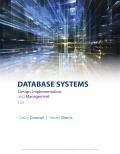
(a)
UNION set operator:
The UNION set operator is used to combine the output of two or more than two queries and produce a result. The produced result contains unique values.
Syntax:
QUERY UNION QUERY;
Consider two tables:
Table creation:
CREATE TABLE VENDOR(VEND_CODE INT PRIMARY KEY);
CREATE TABLE PRODUCT(PROD_CODE VARCHAR(5), VEND_CODE INT,FOREIGN KEY (VEND_CODE) REFERENCES VENDOR (VEND_CODE));
Inserting values:
INSERT INTO VENDOR VALUES(123);
INSERT INTO VENDOR VALUES(124);
INSERT INTO VENDOR VALUES(125);
INSERT INTO VENDOR VALUES(126);
INSERT INTO PRODUCT VALUES('ABC', 125);
INSERT INTO PRODUCT VALUES('DEF', 124);
INSERT INTO PRODUCT VALUES('GHI', 124);
INSERT INTO PRODUCT VALUES('JKL', 123);
(b)
UNION ALL set operator:
The UNION ALL set operator is used to combine the output of two or more than two queries and produce a result. The produced result contains duplicate values.
Syntax:
QUERY UNION ALL QUERY;
Consider two tables:
Table creation:
CREATE TABLE VENDOR(VEND_CODE INT PRIMARY KEY);
CREATE TABLE PRODUCT(PROD_CODE VARCHAR(5), VEND_CODE INT,FOREIGN KEY (VEND_CODE) REFERENCES VENDOR (VEND_CODE));
Inserting values:
INSERT INTO VENDOR VALUES(123);
INSERT INTO VENDOR VALUES(124);
INSERT INTO VENDOR VALUES(125);
INSERT INTO VENDOR VALUES(126);
INSERT INTO PRODUCT VALUES('ABC', 125);
INSERT INTO PRODUCT VALUES('DEF', 124);
INSERT INTO PRODUCT VALUES('GHI', 124);
INSERT INTO PRODUCT VALUES('JKL', 123);
(c)
INTERSECT set operator:
The INTERSECT set operator is used to combine the output of two or more than two queries and produce a result. The produced result contains the values (rows) that are common in both the tables.
Syntax:
QUERY INTERSECT QUERY;
Consider two tables:
Table creation:
CREATE TABLE VENDOR(VEND_CODE INT PRIMARY KEY);
CREATE TABLE PRODUCT(PROD_CODE VARCHAR(5), VEND_CODE INT,FOREIGN KEY (VEND_CODE) REFERENCES VENDOR (VEND_CODE));
Inserting values:
INSERT INTO VENDOR VALUES(123);
INSERT INTO VENDOR VALUES(124);
INSERT INTO VENDOR VALUES(125);
INSERT INTO VENDOR VALUES(126);
INSERT INTO PRODUCT VALUES('ABC', 125);
INSERT INTO PRODUCT VALUES('DEF', 124);
INSERT INTO PRODUCT VALUES('GHI', 124);
INSERT INTO PRODUCT VALUES('JKL', 123);
(d)
EXCEPT/ MINUS set operator:
The MINUS set operator is used to combine the output of two or more than two queries and produce a result. The produced result contains the values (rows) that appear in the first table but not in the second table. The word “EXCEPT” can also be used in the place of “MINUS”.
Syntax:
QUERY EXCEPT QUERY;
Consider two tables:
Table creation:
CREATE TABLE VENDOR(VEND_CODE INT PRIMARY KEY);
CREATE TABLE PRODUCT(PROD_CODE VARCHAR(5), VEND_CODE INT,FOREIGN KEY (VEND_CODE) REFERENCES VENDOR (VEND_CODE));
Inserting values:
INSERT INTO VENDOR VALUES(123);
INSERT INTO VENDOR VALUES(124);
INSERT INTO VENDOR VALUES(125);
INSERT INTO VENDOR VALUES(126);
INSERT INTO PRODUCT VALUES('ABC', 125);
INSERT INTO PRODUCT VALUES('DEF', 124);
INSERT INTO PRODUCT VALUES('GHI', 124);
INSERT INTO PRODUCT VALUES('JKL', 123);
Trending nowThis is a popular solution!

Chapter 8 Solutions
EBK DATABASE SYSTEMS: DESIGN, IMPLEMENT
- Capsim Team PowerPoint Presentations - Slide Title: Key LearningsWhat were the key learnings that you discovered as a team through your Capsim simulation?arrow_forwardWrite the SQL code that permits to implement the tables: Student and Transcript. NB: Add the constraints on the attributes – keys and other.arrow_forwardDraw an ERD that will involve the entity types: Professor, Student, Department and Course. Be sure to add relationship types, key attributes, attributes and multiplicity on the ERD.arrow_forward
- Draw an ERD that represents a book in a library system. Be sure to add relationship types, key attributes, attributes and multiplicity on the ERD.arrow_forward2:21 m Ο 21% AlmaNet WE ARE HIRING Experienced Freshers Salesforce Platform Developer APPLY NOW SEND YOUR CV: Email: hr.almanet@gmail.com Contact: +91 6264643660 Visit: www.almanet.in Locations: India, USA, UK, Vietnam (Remote & Hybrid Options Available)arrow_forwardProvide a detailed explanation of the architecture on the diagramarrow_forward
- hello please explain the architecture in the diagram below. thanks youarrow_forwardComplete the JavaScript function addPixels () to calculate the sum of pixelAmount and the given element's cssProperty value, and return the new "px" value. Ex: If helloElem's width is 150px, then calling addPixels (hello Elem, "width", 50) should return 150px + 50px = "200px". SHOW EXPECTED HTML JavaScript 1 function addPixels (element, cssProperty, pixelAmount) { 2 3 /* Your solution goes here *1 4 } 5 6 const helloElem = document.querySelector("# helloMessage"); 7 const newVal = addPixels (helloElem, "width", 50); 8 helloElem.style.setProperty("width", newVal); [arrow_forwardSolve in MATLABarrow_forward
 Database Systems: Design, Implementation, & Manag...Computer ScienceISBN:9781305627482Author:Carlos Coronel, Steven MorrisPublisher:Cengage Learning
Database Systems: Design, Implementation, & Manag...Computer ScienceISBN:9781305627482Author:Carlos Coronel, Steven MorrisPublisher:Cengage Learning Database Systems: Design, Implementation, & Manag...Computer ScienceISBN:9781285196145Author:Steven, Steven Morris, Carlos Coronel, Carlos, Coronel, Carlos; Morris, Carlos Coronel and Steven Morris, Carlos Coronel; Steven Morris, Steven Morris; Carlos CoronelPublisher:Cengage LearningNp Ms Office 365/Excel 2016 I NtermedComputer ScienceISBN:9781337508841Author:CareyPublisher:Cengage
Database Systems: Design, Implementation, & Manag...Computer ScienceISBN:9781285196145Author:Steven, Steven Morris, Carlos Coronel, Carlos, Coronel, Carlos; Morris, Carlos Coronel and Steven Morris, Carlos Coronel; Steven Morris, Steven Morris; Carlos CoronelPublisher:Cengage LearningNp Ms Office 365/Excel 2016 I NtermedComputer ScienceISBN:9781337508841Author:CareyPublisher:Cengage
 A Guide to SQLComputer ScienceISBN:9781111527273Author:Philip J. PrattPublisher:Course Technology Ptr
A Guide to SQLComputer ScienceISBN:9781111527273Author:Philip J. PrattPublisher:Course Technology Ptr





